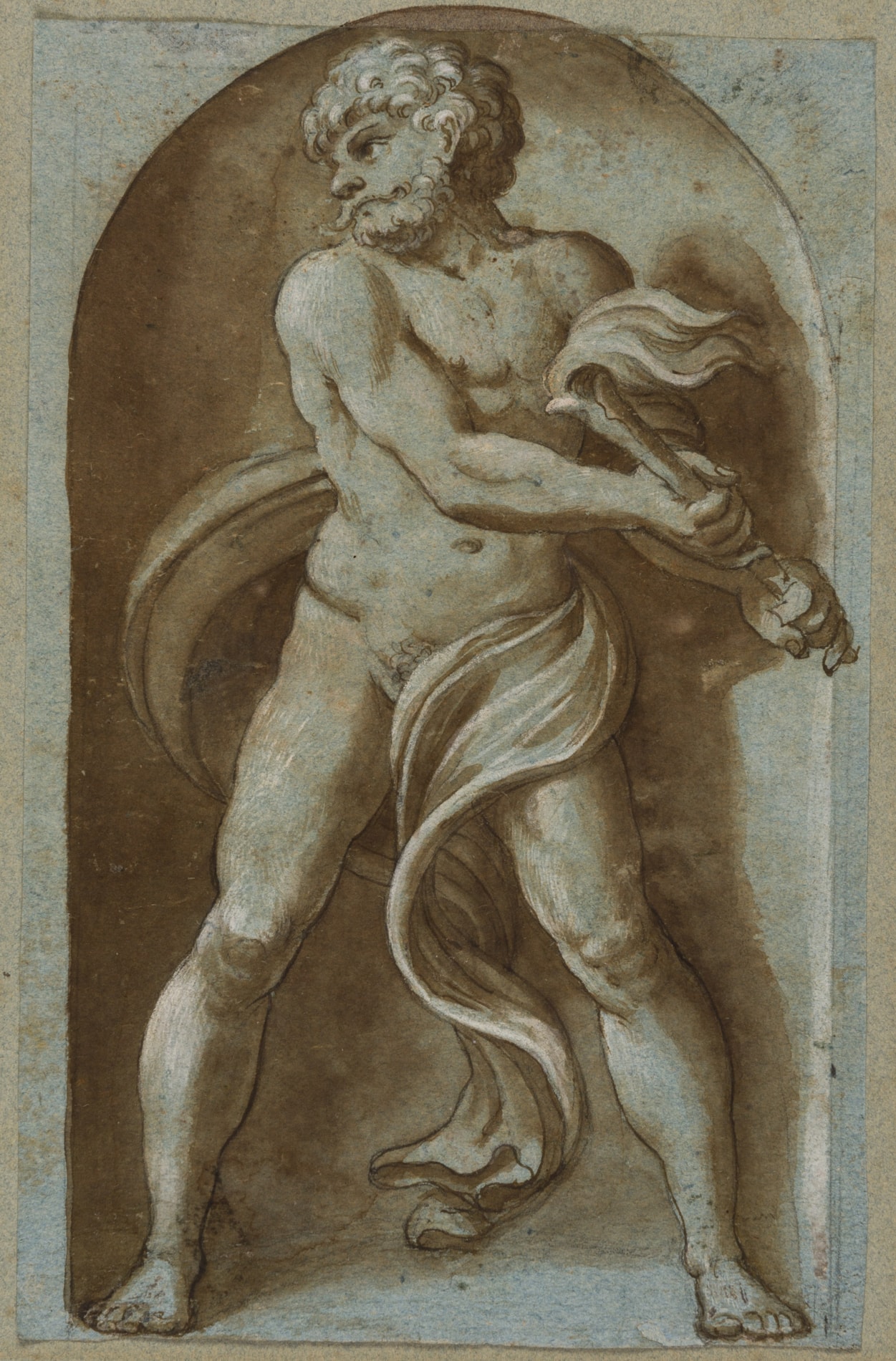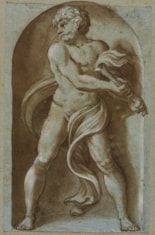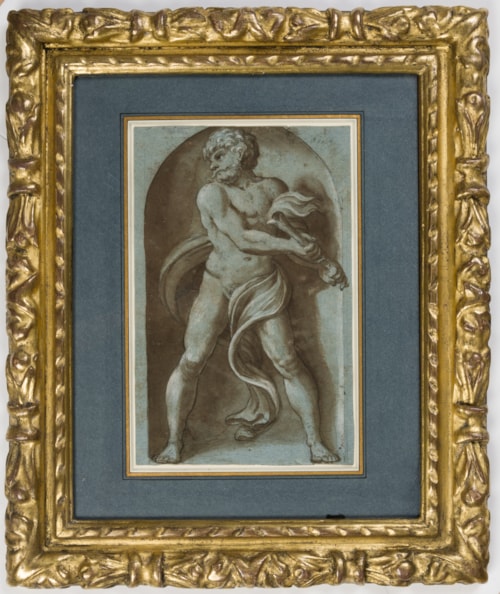Hendrick GOLTZIUS
(Muhlbracht 1558 - Haarlem 1617)
Pluto, after Polidoro da Caravaggio
Pen and brown ink and brown wash, heightened with white, over traces of an underdrawing in black chalk, on blue paper.
Indistinctly inscribed a[?] H. Goltzius/ [?] / E. Reznicek 1994 in pencil on the backing sheet.
264 x 170 mm. (10 3/8 x 6 5/8 in.)
Indistinctly inscribed a[?] H. Goltzius/ [?] / E. Reznicek 1994 in pencil on the backing sheet.
264 x 170 mm. (10 3/8 x 6 5/8 in.)
This fine drawing can be dated to the period of Hendrick Goltzius’s stay in Rome, between January and August 1591. (Although many of Goltzius’s Roman drawings have been lost, fifty-four studies from this trip are today in the Teylers Museum in Haarlem, which houses the largest group of drawings by Goltzius – numbering some 125 sheets in total - in a public collection.) The artist’s brief period in Italy led to a profound and distinct change in his style, as he abandoned the Mannerist figures characteristic of his work of the 1580s in favour of a new, more classical type inspired by the works of the High Renaissance in Italy.
While in Rome, Goltzius was particularly taken with the paintings of the 16th century Italian artist Polidoro da Caravaggio (c.1500-1543), who had developed a particular specialty as a painter of grisaillefrescoes for palace facades, often working in collaboration with a little-known Florentine painter by the name of Maturino. As James Byam Shaw has noted, ‘These façade-paintings, which Vasari always refers to as their joint work, were much admired and copied, especially by foreign artists visiting Rome. Those executed in chiaroscuro monochrome were considered particularly admirable; and their subjects, from ancient history or mythology, chiefly derived from Plutarch, Livy or Ovid, not only flattered the pride of the Romans themselves, but also provided a rich mine of iconography for visiting artists to take home with them. Hardly a trace of these famous paintings now remains on the walls of the Roman palaces.’
Polidoro da Caravaggio’s painted facades were seen throughout Rome, and Goltzius made drawn copies of several of them. The present sheet copies the figure of Pluto, one of a group of now-lost monochrome frescoes by Polidoro of eight Olympian gods in niches that adorned the façade of a house on the Quirinal Hill (also known as Monte Cavallo), near the church of San Silvestro al Quirinale. Although no longer extant, the appearance of the frescoes, which were likely executed after 1524, is recorded in a series of prints published many years later; by Cherubino Alberti in 1590, by Goltzius in 1592, and by Antonio Carenzano and Raffaello Guidi in 16135, as well as a number of drawn copies.
Goltzius made finished pen and wash drawings of each of the eight gods depicted on Polidoro’s façade. Six of these drawings – depicting Saturn, Neptune, Pluto, Vulcan, Jupiterand Mercury- are today in the Teylers Museum in Haarlem. The drawing for Apollois in the Kupferstichkabinett in Berlin, while the last drawing in the series, of Bacchus, has been lost since the 18th century. Among the Haarlem drawings is a slightly larger study of Pluto, the god of the underworld who holds a flaming torch to light his way, with which the present sheet can be closely related. After his return to Haarlem from Italy, Goltzius made engravings of his eight drawings after Polidoro’s Monte Cavallo façade frescoes, adding the name of each god at the bottom. The first print in the series, of Saturn, is dated 1592 and bears a Latin text which translates as: ‘[These] eight heathen gods were painted by Polidoro on a courtyard wall in the quarter of St. Paul’s Convent, on the Quirinal in Rome, now called Monte Cavallo. They are distinguished by the excellence of their clair-obscure effect. HG[oltzius] has sketched them on location and now engraved them for the use of students.’
The Goltzius scholar Emil Reznicek has suggested that the artist first made chalk or pen copies of the Polidoro frescoes in situ, before making more detailed studies in the studio, to serve in turn as models for the engravings. The present drawing of Pluto, which differs slightly from the Haarlem drawing and the related print in some details of the figure, and also does not include the winged figures and the decorative framing elements at the top of the niche, would appear to represent just such an earlier stage in the process of preparing the engravings. As Reznicek has pointed out, ‘Differences such as the figure’s placement in the niche and the more sketchy character of [the present] sheet suggest that it is preparatory for the drawing in Haarlem.’ Goltzius’s engraving of Pluto is, however, the only print in the series for which more than one preparatory drawing is known.
While in Rome, Goltzius was particularly taken with the paintings of the 16th century Italian artist Polidoro da Caravaggio (c.1500-1543), who had developed a particular specialty as a painter of grisaillefrescoes for palace facades, often working in collaboration with a little-known Florentine painter by the name of Maturino. As James Byam Shaw has noted, ‘These façade-paintings, which Vasari always refers to as their joint work, were much admired and copied, especially by foreign artists visiting Rome. Those executed in chiaroscuro monochrome were considered particularly admirable; and their subjects, from ancient history or mythology, chiefly derived from Plutarch, Livy or Ovid, not only flattered the pride of the Romans themselves, but also provided a rich mine of iconography for visiting artists to take home with them. Hardly a trace of these famous paintings now remains on the walls of the Roman palaces.’
Polidoro da Caravaggio’s painted facades were seen throughout Rome, and Goltzius made drawn copies of several of them. The present sheet copies the figure of Pluto, one of a group of now-lost monochrome frescoes by Polidoro of eight Olympian gods in niches that adorned the façade of a house on the Quirinal Hill (also known as Monte Cavallo), near the church of San Silvestro al Quirinale. Although no longer extant, the appearance of the frescoes, which were likely executed after 1524, is recorded in a series of prints published many years later; by Cherubino Alberti in 1590, by Goltzius in 1592, and by Antonio Carenzano and Raffaello Guidi in 16135, as well as a number of drawn copies.
Goltzius made finished pen and wash drawings of each of the eight gods depicted on Polidoro’s façade. Six of these drawings – depicting Saturn, Neptune, Pluto, Vulcan, Jupiterand Mercury- are today in the Teylers Museum in Haarlem. The drawing for Apollois in the Kupferstichkabinett in Berlin, while the last drawing in the series, of Bacchus, has been lost since the 18th century. Among the Haarlem drawings is a slightly larger study of Pluto, the god of the underworld who holds a flaming torch to light his way, with which the present sheet can be closely related. After his return to Haarlem from Italy, Goltzius made engravings of his eight drawings after Polidoro’s Monte Cavallo façade frescoes, adding the name of each god at the bottom. The first print in the series, of Saturn, is dated 1592 and bears a Latin text which translates as: ‘[These] eight heathen gods were painted by Polidoro on a courtyard wall in the quarter of St. Paul’s Convent, on the Quirinal in Rome, now called Monte Cavallo. They are distinguished by the excellence of their clair-obscure effect. HG[oltzius] has sketched them on location and now engraved them for the use of students.’
The Goltzius scholar Emil Reznicek has suggested that the artist first made chalk or pen copies of the Polidoro frescoes in situ, before making more detailed studies in the studio, to serve in turn as models for the engravings. The present drawing of Pluto, which differs slightly from the Haarlem drawing and the related print in some details of the figure, and also does not include the winged figures and the decorative framing elements at the top of the niche, would appear to represent just such an earlier stage in the process of preparing the engravings. As Reznicek has pointed out, ‘Differences such as the figure’s placement in the niche and the more sketchy character of [the present] sheet suggest that it is preparatory for the drawing in Haarlem.’ Goltzius’s engraving of Pluto is, however, the only print in the series for which more than one preparatory drawing is known.
‘The dominant figure in Netherlandish art around 1600’, as noted by one scholar, the Dutch draughtsman and engraver Hendrick Goltzius began his career as a printmaker. He worked as a pupil and assistant of Dirck Volckertsz. Coornhert, and later as an engraver and designer for the publishing houses of Philips Galle and Aux Quatre Vents in Antwerp. His skill with the burin was recognized from an early age, and around 1580 he began publishing his own prints in Haarlem. These soon came to be avidly collected and, as has been noted, ‘The prints that came off Goltzius’s presses count as some of the finest achievements in the history of graphic art.’ Goltzius was always somewhat sickly, and it was after recovering from a severe illness that lasted some three years that he left Haarlem in November 1590 for an extended stay in Italy, where he made a close study of the works of antiquity and the Renaissance. He spent most of his time in Rome, where he arrived at the beginning of 1591 and stayed for several months. There he produced drawn copies after the paintings and frescoes of Raphael and Polidoro da Caravaggio, as well as numerous drawings of the most celebrated antique sculptures to be found in Rome. He left the city at the beginning of August 1591 and returned to Haarlem via Florence, Bologna, Venice and Munich. Although still in poor health, he continued his highly successful career as an engraver and designer of prints, gaining an Imperial privilege from the Emperor Rudolf II in 1595 and dedicating series of engravings to such notable patrons as Duke Wilhelm V of Bavaria and the Archbishop of Milan, Cardinal Federico Borromeo. Among his pupils and assistants in his printmaking studio were Jacques de Gheyn II, Jan Saenredam, Jan Harmensz. Muller and, not least, his stepson Jacob Matham. Around 1600, at the age of forty-two, Goltzius decided to give up printmaking to embark on a new career as a painter, leaving the print workshop and publishing business to Matham.
Goltzius was a highly gifted draughtsman, and over five hundred drawings by him survive. As has been noted of the artist, ‘His technical skill, the virtuosity of his style, and the brilliance and erudition of his inventions in printmaking were matched only by his achievements as a draftsman…Goltzius addressed a wide variety of subjects, from recondite allegories rendered in an extravagant late mannerist mode to precise, naturalistic studies of landscapes, animals, and plants. He experimented with most of the drawing media available to him, including red and black chalks, colored chalks, ink and wash, watercolor and gouache, and metalpoint.’
Goltzius was a highly gifted draughtsman, and over five hundred drawings by him survive. As has been noted of the artist, ‘His technical skill, the virtuosity of his style, and the brilliance and erudition of his inventions in printmaking were matched only by his achievements as a draftsman…Goltzius addressed a wide variety of subjects, from recondite allegories rendered in an extravagant late mannerist mode to precise, naturalistic studies of landscapes, animals, and plants. He experimented with most of the drawing media available to him, including red and black chalks, colored chalks, ink and wash, watercolor and gouache, and metalpoint.’
Provenance
Emile E. Wolf, New York, by 1979
Given by him to Lisa Walborksy, New York, in 1984
Anonymous sale, Amsterdam, Sotheby’s, 8 November 2000, lot 35
By descent in the family of Emile Wolf.
Given by him to Lisa Walborksy, New York, in 1984
Anonymous sale, Amsterdam, Sotheby’s, 8 November 2000, lot 35
By descent in the family of Emile Wolf.
Literature
Creighton E. Gilbert et al, Dutch Drawings of the Seventeenth Century from a Collection, exhibition catalogue, Ithaca, 1979, unpaginated, no.5; E. K. J. Reznicek, ‘Hendrik Goltzius 1558-1617: the complete engravings and woodcuts’ [book review], Simiolus: Netherlands Quarterly for the History of Art, 1978-1979, p.203, under Strauss 291; Walter L. Strauss, ed., The Illustrated Bartsch. 3 (Commentary). Netherlandish Artists: Hendrick Goltzius, New York, 1982, p.285, under no.0301.251; E. K. J. Reznicek, ‘Drawings by Hendrick Goltzius, Thirty Years Later: Supplement to the 1961 catalogue raisonné’, Master Drawings, Autumn 1993, p.250, no.K241a;Holm Bevers, ‘Unpublished Drawings by Hendrick Goltzius in Berlin’, Master Drawings, Winter 1997, p.394, under no.3;Marjolein Leesberg and Huigen Leeflang, The New Hollstein: Dutch & Flemish Etchings, Engravings and Woodcuts 1450-1700. Hendrick Goltzius, Part 2, Ouderkerk aan der IJssel, 2012, p.256, under No.(317) (as ‘likely to be a copy’); Yvonne Bleyerveld and Ilja M. Veldman, The Netherlandish Drawings of the 16th Century in Teylers Museum, Haarlem, 2016, p.146.
Exhibition
Ithaca, NY, Herbert F. Johnson Museum of Art, Cornell University, Dutch Drawings of the Seventeenth Century from a Collection, 1979, no.5.





